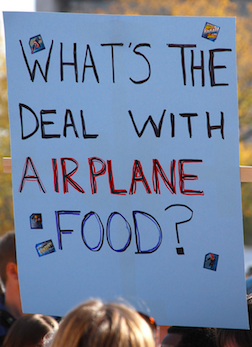Airplane Food: From Multi-Course Meals To Warmed Up Bowls Of Something
A number of factors, including the advancement of airplane technology, have led to today’s sometimes unpleasing airline cuisine, the Atlantic reports.
When the age of flight first began, passenger entertainment centered around multi-course meals, much like you would find in restaurant. But that was back when there were significantly fewer consumers taking to the skies.
MORE PASSENGERS, LESS FOOD
Over the years as flying became more affordable and a popular means of transportation for consumers, airlines weren’t able to keep up with demand.
“It gets more expensive,” Guillaume de Syon, a professor of history at Albright College tells The Atlantic, “flight technology gets better, it gets faster, and you can carry more people. You no longer have the same economies of scale. If you’re trying to feed 60 passengers, it’s one thing, but the moment you’re trying to feed four flights of 150, you have yourself a huge logistical problem.”
So in the early 1950s economy class was created and brought with it a decline in the quality of food. While some airlines tried to remain competitive by offering some specialty foods, the International Air Transport Association put its foot down and began to regulate what could be offered.
Passengers in first class were able to continue receiving elaborate meals, but their food quality likely declined, as well, thanks to the changing airplane technology.
MODERN FLYING WREAKS HAVOC
Modern airplanes are pressurized so they can create a smoother flight traveling at altitudes of 35,000 feet or more. While that advancement means you can breathe comfortably high in the air, it also means your taste buds are numbed.
Additionally, the pressurization creates a drier air, which can weaken your sense of smell. So, with weakened smell and taste senses it’s no surprise that airplane food, no matter how it’s prepared, doesn’t taste as great as it does on the ground.
Cabin humidity in modern airplanes is typically lower than 20% which tends to dry out noses and weaken ones sense of smell. And because cabin air is recirculated continuously, food tends to dry out and cool down quickly on planes.
While airlines have solved some issues, such as keeping meat from drying out at high altitude by using rich sauces, they are still working on others.
FOOD OF THE FUTURE
The Fraunhofer Institute in Germany uses a simulated aircraft cabin environment to test different food flavors and smells for flight.
A 2012 study by the institute looked at how much of a compound was needed before a subject could detect it’s flavor or smell. As was expected, the institute found that low pressure lent itself to better detection.
The institute recommended that airline caterers spice food more to make it more enjoyable for passengers.
However, adding salt and sugar to the meals make them less healthy, says Dr. Charles Platkin, a lecturer at Hunter College and the City University of New York School of Public Health.
Platkin, who does an annual study of the average number of calories found in airline food, says that some airlines are moving toward healthier options for travelers.
While airlines continue to make advancements in their food preparation and offering, consumers are increasingly turning to other aspects of the flight for entertainment, such as in-flight movies.
“Passengers are happier spending two hours watching a movie than getting bored of the food, or getting too drunk,” de Syon says. “A big problem airlines encounter is that the drunkenness often leads to air rage. [Better to] have them focus on a screen or enjoy themselves on the Internet.”
Why Airplane Food Is So Bad [The Atlantic]
Want more consumer news? Visit our parent organization, Consumer Reports, for the latest on scams, recalls, and other consumer issues.


